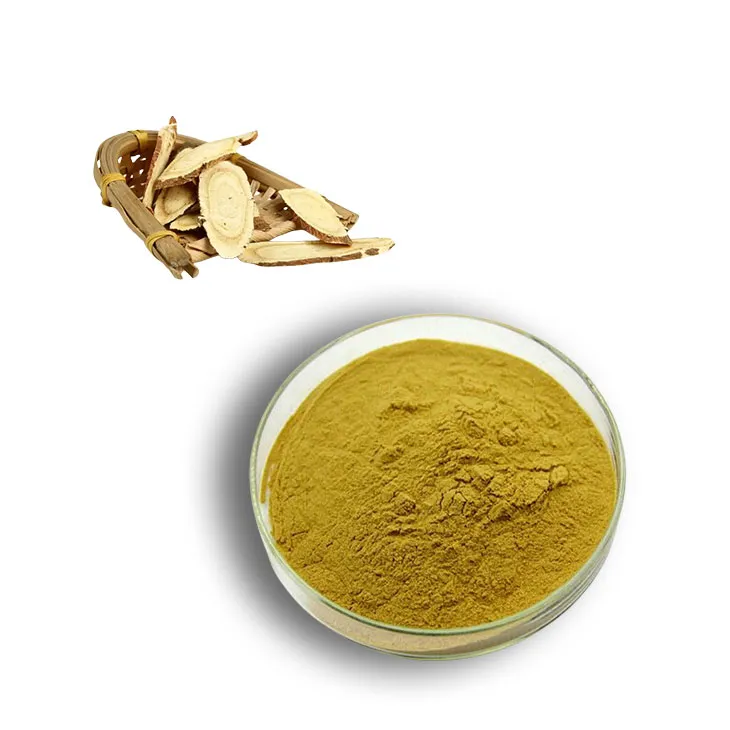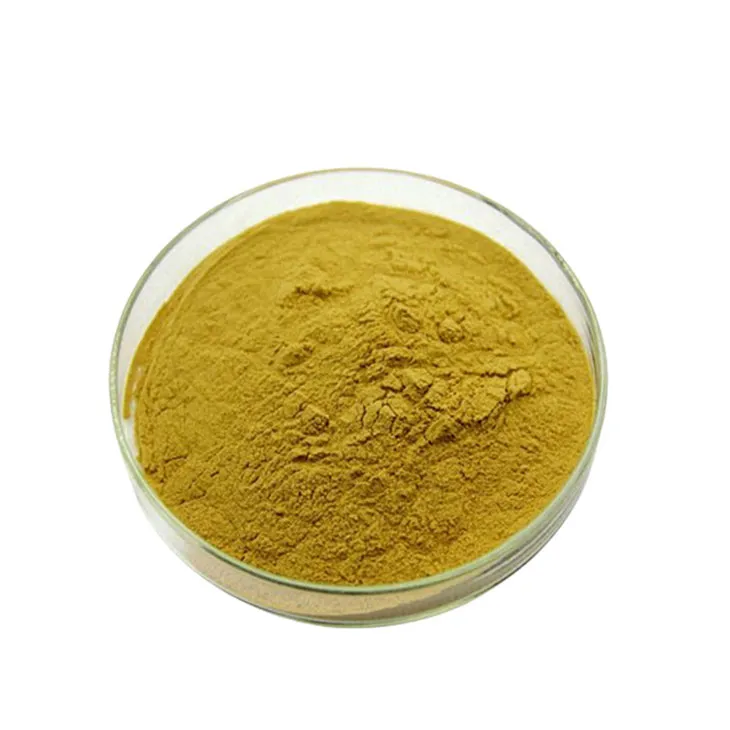- 0086-571-85302990
- sales@greenskybio.com
Four Main Methods for Extracting Licorice Root Extract Powder from Plants.
2024-12-21

1. Introduction
Licorice Root Extract Powder has a wide range of applications in various fields, such as medicine, cosmetics, and food. Effective extraction methods are crucial to obtain high - quality extract powder. In this article, we will explore four main methods for extracting Licorice Root Extract Powder from plants.

2. Solvent Extraction
2.1 Principle
Solvent extraction is based on the principle that the active components in licorice root can be dissolved in certain solvents. Different solvents have different solubilities for various substances in licorice root.
2.2 Solvents Selection- Ethanol: It is a commonly used solvent. Ethanol has good solubility for many active ingredients in licorice root, such as glycyrrhizic acid. Moreover, ethanol is relatively safe and easy to obtain. - Water: Water can also be used as a solvent. It is especially suitable for extracting water - soluble components in licorice root. However, the extract obtained by water extraction may contain more impurities compared to ethanol extraction.
2.3 Procedure1. First, the licorice root needs to be dried and crushed into a fine powder. This step is important as it increases the surface area of the licorice root, facilitating the contact between the solvent and the active components. 2. Then, the powdered licorice root is placed in a Soxhlet extractor or a simple extraction vessel. Add the selected solvent (for example, ethanol or water) in an appropriate ratio. 3. Heat the extraction system under reflux conditions. The temperature and time of extraction should be carefully controlled. For ethanol extraction, a temperature of around 70 - 80°C and an extraction time of 2 - 4 hours are usually appropriate. For water extraction, a lower temperature (such as 60 - 70°C) may be used, and the extraction time can be extended to 4 - 6 hours. 4. After extraction, the extract is filtered to remove the solid residues. The filtrate is then concentrated under reduced pressure to obtain a thick extract. 5. Finally, the thick extract can be further dried, for example, by spray drying or freeze - drying, to obtain the Licorice Root Extract Powder.
2.4 Advantages and Disadvantages- Advantages: Solvent extraction is a relatively simple and widely applicable method. It can effectively extract a variety of active components from licorice root. Ethanol extraction can also provide a certain degree of sterilization effect, which is beneficial for the preservation of the extract. - Disadvantages: The use of solvents may bring potential safety hazards, especially for organic solvents. And the extraction process may be time - consuming and energy - consuming, especially when large - scale production is required.

3. Supercritical Fluid Extraction
3.1 Principle
Supercritical fluid extraction utilizes the properties of supercritical fluids. Supercritical fluids have the properties of both liquids and gases. For example, carbon dioxide in the supercritical state has a high density like a liquid, which enables it to dissolve many substances, and at the same time, it has a low viscosity and high diffusivity like a gas, which makes it easy to penetrate into the matrix of licorice root.
3.2 Supercritical Fluid SelectionCarbon dioxide is the most commonly used supercritical fluid in the extraction of licorice root extract powder. It is non - toxic, non - flammable, and has a relatively low critical temperature and pressure (critical temperature is about 31.1°C, and critical pressure is about 7.38 MPa), which is easy to achieve in practical operations.
3.3 Procedure1. Prepare the licorice root sample by drying and grinding it to an appropriate particle size. 2. Load the licorice root sample into the supercritical fluid extraction equipment. 3. Pump carbon dioxide into the system and adjust the temperature and pressure to make it reach the supercritical state. For example, the extraction temperature can be set between 40 - 60°C, and the pressure can be set between 10 - 30 MPa. 4. The supercritical carbon dioxide will dissolve the active components in the licorice root and then be transferred to the separation unit. 5. In the separation unit, by changing the temperature or pressure conditions, the solubility of the supercritical carbon dioxide decreases, and the active components are precipitated. 6. Finally, the obtained licorice root extract can be dried to obtain the powder form.
3.4 Advantages and Disadvantages- Advantages: Supercritical fluid extraction is a clean and environmentally friendly method. Since carbon dioxide is non - toxic and easily removed from the extract, there is no solvent residue problem. It can also precisely control the extraction process by adjusting the temperature and pressure, which is conducive to obtaining high - quality extract powder with high purity. - Disadvantages: The equipment for supercritical fluid extraction is relatively expensive, which requires a high initial investment. And the operation process is relatively complex, requiring professional technicians to operate.

4. Microwave - Assisted Extraction
4.1 Principle
Microwave - assisted extraction is based on the principle that microwaves can interact with polar molecules in licorice root. When microwaves irradiate the licorice root sample, the polar molecules in it will be excited and generate heat rapidly, which accelerates the extraction process of active components.
4.2 Procedure1. Prepare the licorice root material as in the previous methods, drying and grinding it. 2. Place the powdered licorice root in a microwave - transparent extraction vessel. Add an appropriate solvent (such as ethanol or water). 3. Place the extraction vessel in a microwave oven. Set the appropriate microwave power and extraction time. For example, the microwave power can be set between 300 - 600 W, and the extraction time can be 5 - 15 minutes. 4. After extraction, filter the extract to remove the solid impurities. 5. Concentrate and dry the filtrate to obtain the licorice root extract powder.
4.3 Advantages and Disadvantages- Advantages: Microwave - assisted extraction has a very short extraction time compared to traditional extraction methods. It can significantly improve the extraction efficiency, reduce energy consumption, and also has a certain degree of selectivity for the extraction of active components. - Disadvantages: The extraction effect may be affected by the distribution of microwave energy, and if not properly controlled, it may lead to local overheating, which may cause the degradation of some active components.

5. Ultrasonic - Assisted Extraction
5.1 Principle
Ultrasonic - assisted extraction is based on the cavitation effect of ultrasonic waves. When ultrasonic waves are transmitted in the solvent - licorice root system, cavitation bubbles are generated, which collapse violently and generate strong shock waves and micro - jets. These can break the cell walls of licorice root, promote the release of active components, and increase the mass transfer rate between the active components and the solvent.
5.2 Procedure1. Prepare the licorice root sample, drying and grinding it to a suitable powder. 2. Put the powdered licorice root in an ultrasonic extraction vessel. Add the solvent (ethanol or water). 3. Immerse the ultrasonic probe into the extraction system or use an ultrasonic bath. Set the appropriate ultrasonic frequency and extraction time. For example, the ultrasonic frequency can be set between 20 - 50 kHz, and the extraction time can be 15 - 30 minutes. 4. After extraction, filter the extract to get rid of the solid residues. 5. Concentrate and dry the filtrate to obtain the licorice root extract powder.
5.3 Advantages and Disadvantages- Advantages: Ultrasonic - assisted extraction can effectively break the cell structure of licorice root, improve the extraction rate of active components. It is also a relatively simple and energy - efficient method. - Disadvantages: The ultrasonic intensity needs to be carefully controlled. Excessive ultrasonic intensity may cause the denaturation of some active components. And the extraction efficiency may be limited for some complex components.
6. Conclusion
Each of the four extraction methods for licorice root extract powder has its own advantages and disadvantages. Solvent extraction is a traditional and widely used method, while supercritical fluid extraction is more environmentally friendly and can obtain high - quality products. Microwave - assisted extraction and ultrasonic - assisted extraction can improve extraction efficiency. In actual production, the selection of extraction method should be based on factors such as the required quality of the extract powder, production scale, cost, and environmental requirements.
FAQ:
What are the four main methods for extracting licorice root extract powder?
The four main methods usually include solvent extraction, which uses solvents like ethanol or water to dissolve the active components from licorice root; supercritical fluid extraction, which takes advantage of supercritical fluids such as supercritical CO₂ to extract; microwave - assisted extraction, where microwave energy is used to enhance the extraction process; and ultrasonic - assisted extraction, which utilizes ultrasonic waves to improve the extraction efficiency.
Which method is the most cost - effective for extracting licorice root extract powder?
The cost - effectiveness of the method depends on various factors. Solvent extraction can be relatively cost - effective in terms of equipment, but it may have higher solvent costs and longer extraction times. Supercritical fluid extraction may have high initial equipment costs but can be more efficient and produce a higher - quality extract. Microwave - assisted and ultrasonic - assisted extractions may also have their own cost - benefit ratios depending on the scale of production and energy costs in a particular region.
What are the advantages of supercritical fluid extraction in licorice root extract powder extraction?
Supercritical fluid extraction has several advantages. It can operate at relatively low temperatures, which helps to preserve the thermally sensitive components of licorice root. It also has a high selectivity, allowing for the extraction of specific components with greater precision. Additionally, the supercritical fluid can be easily removed from the extract, leaving behind a relatively pure product, and it is considered a more environmentally friendly method compared to some traditional solvent - based extractions.
How does ultrasonic - assisted extraction improve the extraction of licorice root extract powder?
Ultrasonic - assisted extraction works by creating cavitation bubbles in the solvent. When these bubbles collapse, they generate high - intensity shock waves and micro - jets that can disrupt the cell walls of licorice root, facilitating the release of the active components into the solvent. This results in a more efficient extraction process, often reducing the extraction time and potentially increasing the yield of the extract.
Are there any safety concerns associated with these extraction methods?
For solvent extraction, if flammable or toxic solvents are used, there are safety risks such as fire hazards and solvent exposure risks. However, proper safety protocols can mitigate these risks. Supercritical fluid extraction, especially with CO₂, is generally considered safe as CO₂ is non - flammable and non - toxic. Microwave - assisted extraction requires proper shielding to prevent microwave leakage, and ultrasonic - assisted extraction needs to ensure that the ultrasonic equipment is operating within safe parameters to avoid potential damage to the operators or the environment.
Related literature
- Advances in Licorice Root Extraction Techniques"
- "Efficient Extraction of Licorice Root Extract Powder: A Review"
- "Comparative Study of Different Extraction Methods for Licorice Root"
- ▶ Hesperidin
- ▶ Citrus Bioflavonoids
- ▶ Plant Extract
- ▶ lycopene
- ▶ Diosmin
- ▶ Grape seed extract
- ▶ Sea buckthorn Juice Powder
- ▶ Fruit Juice Powder
- ▶ Hops Extract
- ▶ Artichoke Extract
- ▶ Mushroom extract
- ▶ Astaxanthin
- ▶ Green Tea Extract
- ▶ Curcumin
- ▶ Horse Chestnut Extract
- ▶ Other Product
- ▶ Boswellia Serrata Extract
- ▶ Resveratrol
- ▶ Marigold Extract
- ▶ Grape Leaf Extract
- ▶ New Product
- ▶ Aminolevulinic acid
- ▶ Cranberry Extract
- ▶ Red Yeast Rice
- ▶ Red Wine Extract
-
Black Garlic Extract
2024-12-21
-
Plantain extract
2024-12-21
-
Citrus bioflavonoids
2024-12-21
-
Saffron Extract Powder
2024-12-21
-
Hawthorn powder
2024-12-21
-
Lavender Extract
2024-12-21
-
Hesperidin
2024-12-21
-
Cassia Seed Extract
2024-12-21
-
Nettle Root Extract
2024-12-21
-
Panax Ginseng Leaf Extract
2024-12-21





















